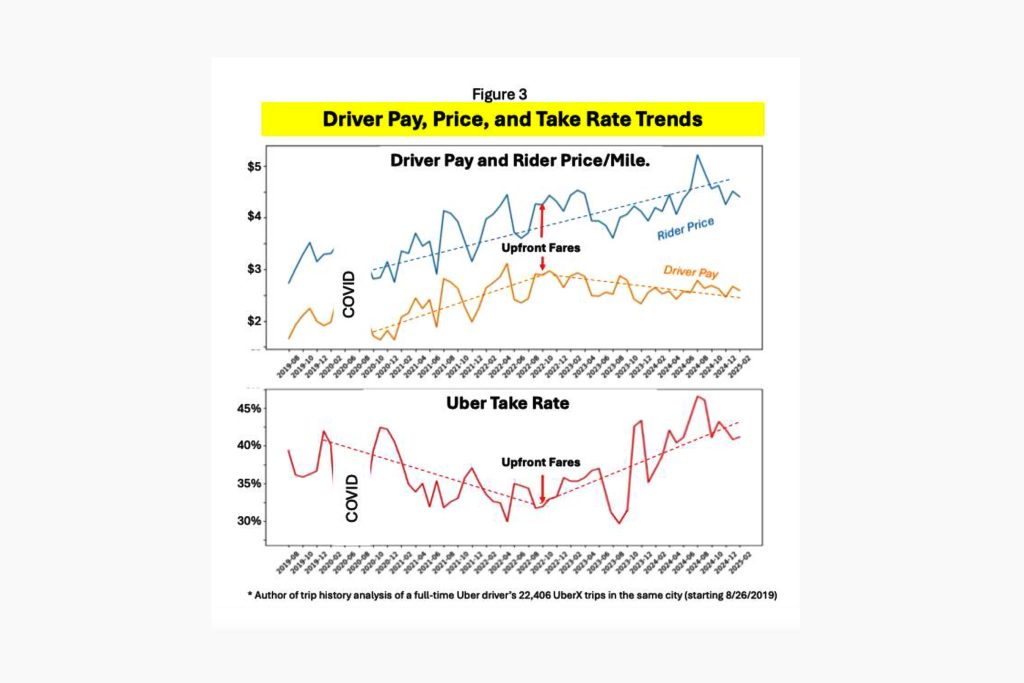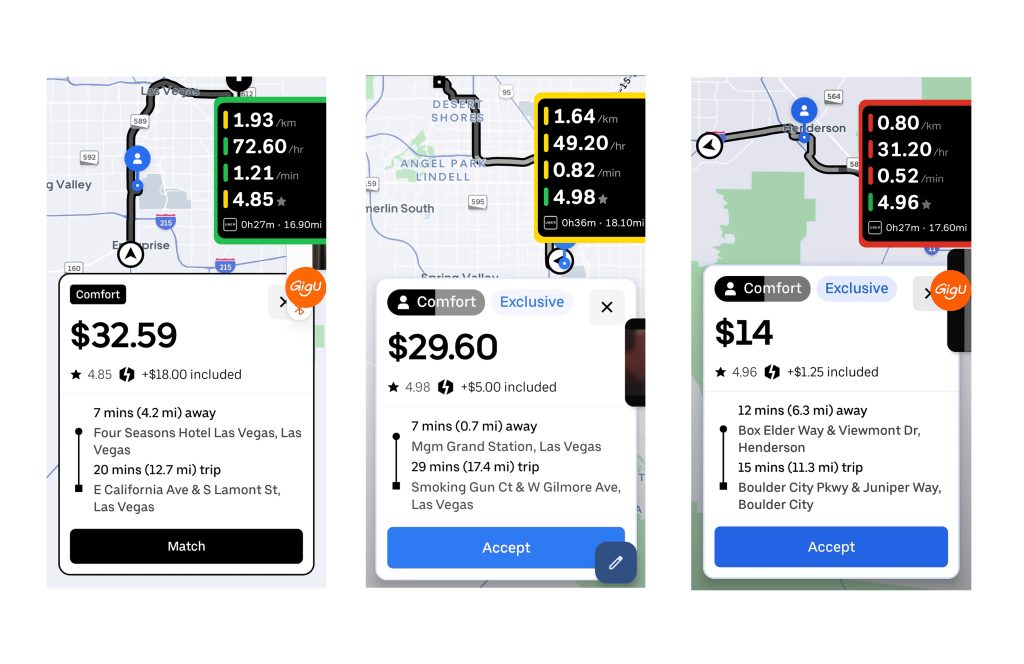As academic research exposes multi-billion-dollar algorithmic exploitation, GigU emerges as the transparency solution that gig drivers desperately need.
The gig economy’s reckoning has arrived with stunning academic precision.
Within the span of a single week, two major university studies have independently exposed what millions of drivers have long suspected: the algorithms governing their livelihoods aren’t neutral arbiters — they’re sophisticated profit-extraction machines designed to systematically reduce driver earnings while boosting platform margins.
The University of Oxford released findings showing that Uber’s “dynamic pricing” algorithm in the U.K. has dramatically increased the company’s take rate from 25% to 29% median, with some trips reaching more than 50%. Days later, Columbia Business School’s Professor Len Sherman published even more damning research revealing that Uber’s “upfront pricing” system in the U.S. has engineered a nearly $4 billion annual wealth transfer from drivers to shareholders in the U.S. alone.
But amid this algorithmic exploitation, a solution has emerged from an unexpected place: Brazil.
GigU, the driver-empowerment platform that successfully challenged Uber in Brazilian courts, has expanded to the U.S. market with tools designed to level the playing field, giving drivers the transparency and optimization capabilities they need to fight back against systematic underpayment.
The Academic Bombshell: Two Studies, One Devastating Conclusion

Sherman’s Columbia research, analyzing more than 24,000 actual Uber trips, reveals the shocking scope of algorithmic manipulation. Since launching “upfront pricing” in Q3 2022, only 22% of 2024 trips were priced within normal distance-and-time parameters, compared to 86% in 2019. The other 78% use what Sherman calls “algorithmic manipulation to charge riders more while paying drivers less.”
The financial impact is staggering.
Uber’s take rate has jumped from 32% to over 42%, a massive wealth extraction from workers struggling with a 20%+ earnings decline since 2022.
Meanwhile, the platform has engineered practices like “surge bonus shaving,” where drivers don’t receive full advertised bonuses, and another scheme where riders pay 6-11% more for objectively worse service while drivers receive little additional compensation.
The Oxford study, examining 1.5 million U.K. trips, confirms this pattern internationally.
Professor Rafael Jiménez-Durán found that many drivers now earn “substantially less” per hour since dynamic pricing launched, with Uber systematically extracting higher percentages while providing less transparency about how pay is calculated.
Together, these studies provide unprecedented academic validation of what drivers have been experiencing: platforms profit by keeping workers in the dark about the true economics of their labor.
The Human Cost: When Algorithms Attack Livelihoods
Behind these statistics are real people struggling to make ends meet.
According to GridWise Analytics, Uber drivers’ earnings have plummeted over 20% from 2022 to 2024, while DoorDash drivers now earn just $12.23 per hour. As one Dallas driver told Business Insider, “There have been days where I received zero tips, and there have been days where I receive a tip every single trip. It really depends on the mood of the city.”
The challenge extends beyond unpredictable tips. The Business Insider analysis in 2023 found that drivers face significant expenses, between $4 and $8 per hour for gas, maintenance, and vehicle costs, which platforms don’t adequately account for in their earnings calculations.
Lyft estimates typical drivers have about $7 per engaged hour in fuel, maintenance, repairs, depreciation, and cleaning expenses, not including fixed costs like car payments and insurance.
This creates a perfect storm: declining platform payouts, rising operational costs, and algorithms designed to obscure whether rides are actually profitable. As Sherman notes in his research, drivers typically have less than ten seconds to evaluate ride offers while safely operating vehicles, without access to the information needed to make informed business decisions.
Research from organizations like Business & Human Rights Resource Centre highlights additional concerns, including independent contractor misclassification, algorithmic management creating unpredictable pay and mental health issues, and a lack of transparency in pay calculations.
Safety studies show 42% of gig workers have damaged vehicles in work-related collisions, 47% break speed limits due to time pressures, and 16% struggle to stay awake while driving.
David vs. Goliath: How GigU Beat Uber in Court before Coming North
Enter GigU, the Brazilian app that has become the antithesis of algorithmic exploitation. Originally launched as StopClub in 2018, the platform caught Uber’s attention, and legal ire, by providing drivers with exactly what the academic studies show they lack: transparency.
When GigU launched tools to help drivers understand their true earnings in Brazil, Uber sued them in July 2023, claiming the app illegally obtained confidential data. GigU countered that it simply reads information shown on screen and performs calculations to help drivers make better decisions, exactly what drivers need, but platforms don’t want to provide.
The legal battle proved pivotal. In August 2023, Uber lost its injunction to block the app in a unanimous 3-0 judges’ decision. The publicity actually accelerated GigU’s growth from 87,000 active users in February 2023 to 250,000 by September.
More importantly, GigU filed a complaint against Uber with CADE, Brazil’s antitrust authority. In February 2025, CADE launched an investigation into Uber’s business practices, ordering the company to provide data on operations and driver bans dating back to 2020.
This David vs. Goliath victory demonstrates that platform transparency isn’t just possible — it’s legally defensible and desperately needed.
The Cherry Picker Solution: Technology as Driver Empowerment
GigU’s flagship “Cherry Picker” feature addresses the core problem identified in both studies: information asymmetry. The tool analyzes ride offers and provides drivers with rapid, color-coded recommendations — green for profitable rides, yellow for acceptable options, red for trips to avoid.

“We built GigU by working directly with drivers, eating with them, listening to them, and understanding their daily challenges since 2017,” explains Pedro Inada, co-CEO and co-founder. The platform’s approach directly counters what Sherman calls platforms’ “aggressive technical and legal tactics to prevent data service providers from providing useful decision support tools.”
The results speak for themselves. Brazilian drivers using GigU have increased earnings by up to 30% on average, with nearly 600,000 app downloads, 181,000 active users, and 70,000 paying subscribers. Now available in the U.S. for $6.95 monthly after a free 30-day trial, the platform offers American drivers the same transparency tools that proved successful in Brazil.
Additionally, GigU’s “Secret Camera” feature provides additional protection by transforming smartphones into networked security cameras connected to Google Cloud, offering evidence during disputes, addressing safety concerns highlighted in recent studies showing violence against drivers and pressure to accept unsafe rides.
GigU is now developing a profit-tracking tool scheduled for July release, designed to help drivers understand exactly what they need to earn after accounting for all expenses, addressing the opacity that Business Insider‘s analysis shows makes it difficult for drivers to calculate true hourly wages.
Fighting Back: From Academic Research to Regulatory Action
The convergence of academic research, legal victories, and technological solutions is creating unprecedented momentum for driver empowerment. Sherman’s research explicitly identifies GigU as a threat to platform profit extraction, noting Uber’s resistance to “data service providers that make prices and pay rates more transparent.”
The lack of transparency in the past is driving regulatory action. Chicago’s City Council is pushing for a $21.51 minimum hourly rate. Oregon has advanced comprehensive protections, including guaranteed minimum pay and transparent fee structures. Wisconsin lawmakers are debating similar measures, while New York, California, and Seattle have enacted minimum pay guarantees.
As Luiz Gustavo Neves, GigU’s co-CEO, writes in the company’s manifesto: “When platforms deploy ‘aggressive technical and legal tactics’ against transparency tools, they’re admitting their business models depend on information asymmetry.”
The academic studies provide smoking-gun evidence that algorithmic opacity isn’t just unfair — it’s what Sherman calls “theft with a smartphone interface.” When respected researchers at Oxford and Columbia independently conclude that platforms systematically exploit drivers through opaque algorithms, the case for transparency tools becomes overwhelmingly clear.
The Future of Fair Gig Work
The confluence of academic validation, legal precedent, and technological solutions represents a turning point for gig work. As both university studies demonstrate, the current system is unsustainable — platforms cannot continue extracting ever-higher percentages while reducing driver earnings without facing consequences.
GigU’s success in Brazil and its recent expansion to the U.S. market prove that transparency tools can work. By providing drivers with the information that platforms deliberately obscure, these technologies flip the algorithmic advantage from extraction to empowerment.
The question isn’t whether companies should profit — it’s whether they should profit by systematically deceiving the workers who create their value. As two major universities have now conclusively shown, that’s exactly what’s happening.
GigU’s cherry-picking remedy, validated by legal victories and proven results, demonstrates that technology can serve workers instead of exploiting them. With its new profit-tracking tool launching in July and continued expansion across the U.S. market, drivers finally have weapons to fight back against algorithmic manipulation.
The algorithmic emperor has no clothes. Academic research has handed drivers the receipts.
Now, armed with transparency tools like GigU, they can demand the dignity and fair compensation they’ve always deserved.
The gig economy’s dignity revolution has begun, and this time, drivers have the data and tools to win.


